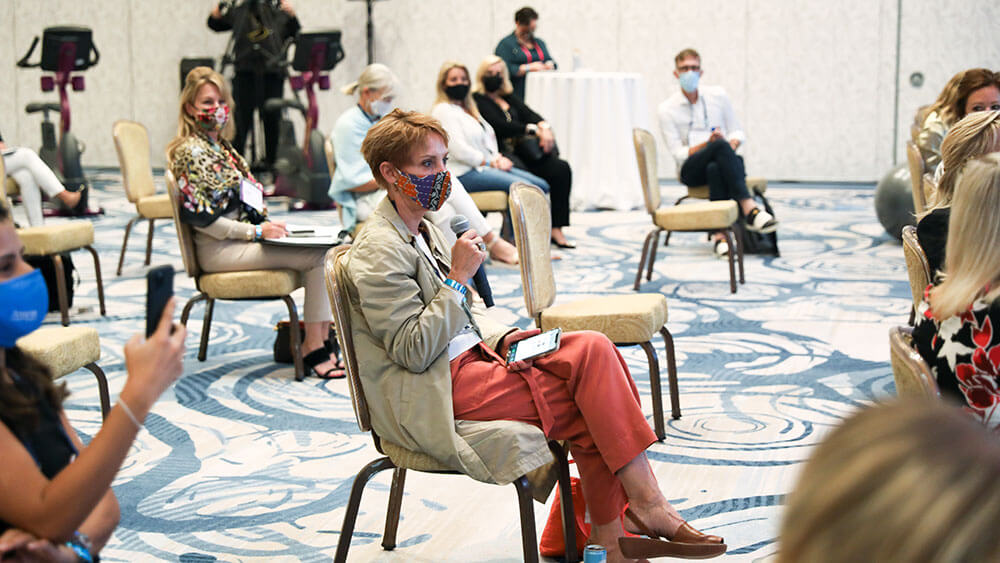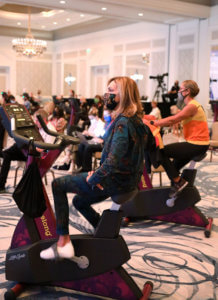
Organizers of the Global Wellness Summit, where mask-wearing was required at all times except while dining, brought in far-UVC lighting technology to kill up to 95 percent of viral loads on skin and clothing.
Changing plans on short notice is nothing new to organizers of the Global Wellness Summit. In 2019, the international conference that regularly attracts attendees from more than 50 countries was set to take place in Hong Kong. Six weeks out, the Hong Kong International Airport shut down due to civil unrest, and organizers decided to make a quick switch to Singapore for the event. So when the COVID-19 pandemic started to spread across the world, they were ready to alter plans at any moment, according to Nancy Davis, Global Wellness Summit’s chief creative officer and executive director.
“Let’s just say we’re the pivot experts at this point,” Davis joked. “Pivoting is in our nature. We have to stay flexible.”
The 2020 Global Wellness Summit, which serves as an educational conference for the spa and wellness communities, was planned to be hosted in mid-November in Tel Aviv, but Davis said she knew the show could not go on in person in Israel, as borders began closing across the world to limit the virus’ spread. With the knowledge that “an enormous part of the wellness industry lives and breathes” in the United States, Davis and her team chose to make Tel Aviv the 2021 event host and move the 2020 summit, the event’s 14th iteration, to Palm Beach, Florida, where they could hold an intimate hybrid event that was easily accessible to many of their attendees.
‘Smartly and Safely’
The in-person component of the Global Wellness Summit took place at The Breakers, a luxury resort, on Nov. 8–11. While Davis acknowledged that planning a hybrid event instead of a fully virtual one was “a risk,” she felt that, as a leading event in the wellness industry, the summit needed to present a model of how events can be held to address “the parallel pandemic to [COVID-19], which is isolation and loneliness,” while still keeping attendees’ physical health top of mind.

Participants chose how they wanted to experience sessions — while exercising or sitting.
“We called Dr. Richard Carmona, the 17th Surgeon General [of the United States], who is on our board and is a close friend of the organization,” Davis said. “We asked what he thought about gathering at a time like this, and he said, ‘Do it. I’ll be there. We’ll do it smartly and safely.’”
Key to offering a safe environment for the in-person event to take place was the choice of venue, Davis said. “It was important that we be at The Breakers, because The Breakers is a place where everybody felt safe,” she said. Davis felt completely confident in the venue, “because of the way they deal with their own protocols and team. Their commitment to wellness as an organization is something we’ve honored with awards and they’ve appeared in our research. You just know if you’re there, you’re going to be cared for in a very particular way. Especially at this time.”
Originally, portions of the event, like brainstorming sessions, were set to take place outdoors to take advantage of Florida’s mild autumn temperatures, as well as for optimal safety, but “hashtag 2020, right?” Davis said with a laugh.
A hurricane forced the entire event indoors, but organizers still took every precaution to make the environment as safe as possible. Global Wellness Summit organizers brought in far-UVC lighting technology in the space to kill up to 95 percent of viral loads on skin and clothing, as well as two air-purification systems. Mask-wearing was required at all times except while dining — even for speakers. On-site rapid testing was organized by a local health-care provider, Premier Family Health & Wellness, and all attendees wore a wristband that indicated that they had tested negative. Additionally, the venue’s security team performed temperature checks each day of the summit.
The approximately 100 people in attendance were spaced at least six feet apart from one another in the 15,000-square-foot ballroom and could choose to watch the sessions from a traditional banquet chair, stability ball, recumbent bike, or elliptical. At breaks, all food was pre-packaged and served to individuals by The Breakers staff to eliminate risks associated with multiple people using self-service options.
“We did everything we could to mitigate risk,” Davis said. “The idea was, if we’re going to do this as a wellness organization, we are going to model the best protocol and the best behavior we possibly could. That’s what we did.”
Feeling Included
With delegates from all around the world, the Global Wellness Summit’s Nancy Davis wanted to give international online participants an immersive experience so they didn’t feel left out of the in-person event in Palm Beach, Florida.
“The ‘global’ in our name is really [in our] DNA,” Davis said. “When everything was shut down and all our European and Asian delegates from all over the world could not come, we really felt like we needed to give them a way to be part of this.”
The summit combined live, on-stage keynotes, panels, and presentations with pre-recorded content that had a livestreamed Q&A element at the end of sessions. The summit’s 500 virtual attendees could send their questions in real time to interact with speakers and feel engaged in the content, which was presented as a Zoom Video Webinar. The entire event was recorded, with on-demand sessions — focused largely on wellness issues relating to the pandemic — released the same day for those joining in from different time zones. A total of 73 on-demand videos were available through the end of the year, bundled with the Global Wellness Institute’s research, “Defining the Mental Wellness Economy.”
“The feedback from people who were part of our virtual package has been that they felt like they were really part of something special, and something different,” Davis said, “and the live component made them feel part of something that was more spontaneous and energetic than only watching taped presentations.”
Casey Gale is associate editor at Convene.
